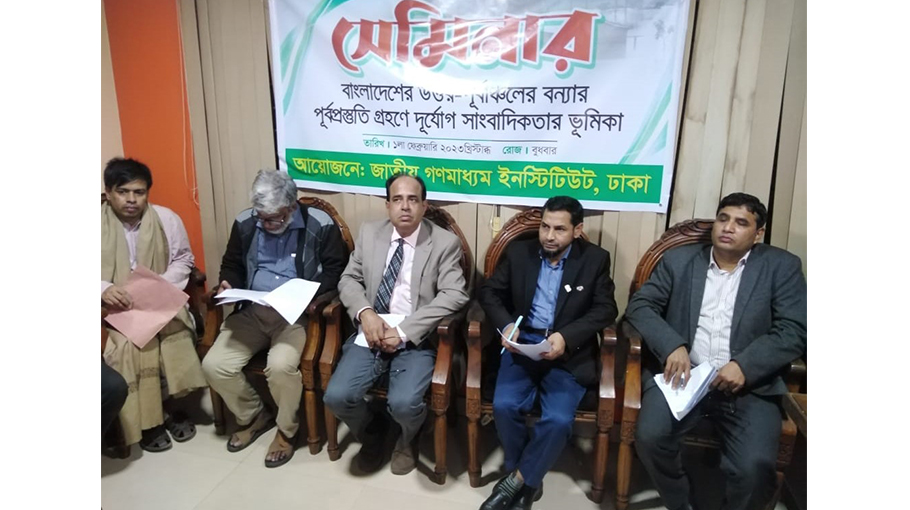No 2022-like floods if disaster journalism evolves
Speakers at NIMC events in Sylhet, Sunamganj


Experts, mass media activists and people of flood-hit areas of Sylhet and Sunamganj districts have said that the northeastern region of the country has not yet overcome the effects of the record-breaking devastating floods that occurred in 2022.
Pre-preparedness would have reduced the damage caused by the frequent floods. However, the institutions concerned had failed to provide forecasts, while there was no forecast, awareness and warning news were seen in the media regarding the 2022 floods, they said at a seminar and some other programmes in Sylhet and Sunamganj.
National Institute of Mass Communication (NIMC), one of the leading training institutes of the country under the Ministry of Information and Broadcasting, arranged the events as part of a research project titled ‘Role of Disaster Journalism for Preparedness to Face Floods in Northeastern Bangladesh’.
One of the events was a seminar which was held at a conference room at Zindabazar in Sylhet city on Wednesday (February 1) evening.
Speakers of the seminar said that if disaster journalism evolves in Bangladesh, there will be no repeat of such terrible floods like 2022 that hit the northeastern region of the country, particularly Sylhet and Sunamganj.
“The northeastern region is a flood-prone area. Alongside the government and others concerned, the mass media should play a vital role so that such terrible floods won’t repeat,” said Dr. Syed Ashrafur Rahman, a professor of Political Studies dept of Shahjalal University of Science and Technology (SUST).
He called upon the journalists to speak out against unplanned development activities and other activities that contribute to devastating floods.
 NIMC deputy director Mohammed Abu Sadique and some other officials attended a views-exchange meeting with local journalists at Sunamganj Reporters Unity on Wednesday.
NIMC deputy director Mohammed Abu Sadique and some other officials attended a views-exchange meeting with local journalists at Sunamganj Reporters Unity on Wednesday.
Echoing the same as Prof Syed Ashrafur Rahman, many other speakers of the seminar said that news items of disaster and affected areas are not highlighted properly in the media, including the mainstream media, due to the fact that disaster journalism is relatively less important in Bangladeshi media. As a result, news items about disaster preparedness, awareness and prevention are rarely seen.
“If disaster journalism is given importance in the mainstream media, there will be no repeat of the terrible floods that occurred in 2022,” said Abdul Hye Al-Hadi, a river conservationist who is the chief coordinator of Save the Saree River.
Mohammed Abu Sadique, a deputy director of NIMC; presided over the seminar, while Ehsanul Haque Jasim, a mass media activist and principal researcher of the research project; presented the main article. Md. Fahim Siddique, research officer of NIMC; delivered the welcome speech.
Prof Dr. Md. Jahir Bin Alam of the Civil and Environmental Engineering dept of SUST; spoke on the occasion as the chief guest, while it was addressed, among others, by Mohammad Sirajul Islam, former general secretary of Sylhet Press Club; Polina Rahman Polin, woman vice chairman of Jaintiapur Upazila Parishad, journalist Shuaibul Islam and lawyer Advocate Sabbir Ahmed.
Highlighting the importance of disaster journalism in preventing and preparing for any disaster including floods, the speakers at the seminar called for inclusion of specialized beat for disaster journalism in the mainstream media.
 NIMC research officer Md. Fahim Siddique and others attended a views-exchange meeting with local journalists at Jaintiapur Press Club in Sylhet district on Monday.
NIMC research officer Md. Fahim Siddique and others attended a views-exchange meeting with local journalists at Jaintiapur Press Club in Sylhet district on Monday.
In his speech, Prof Dr. Md. Jahir Bin Alam said that the 2022 floods were not just due to excessive rainfall; Decrease in navigability of the river, construction of bridges over Surma river at several places, construction of road at Kishoreganj haor and other haor areas and various other reasons are also responsible for the devastating floods.
The expert also said that the media can play a vital role so that such floods don’t happen again. Disaster journalism should be given serious consideration in the media as the media can influence the policy-makers by producing investigative reports, while it can also play a unique role in making people aware.
He called for protecting the drains and waterbodies of Sylhet city to avoid waterlogging and floods.
Earlier on the day, the NIMC officials, including NIMC’s librarian Kazi Omar Khaiyam, and principal researcher and co-researcher of the research project Ali Ahmed held views-exchange meeting with journalists working from Sunamganj. The meeting was held at Sunamganj Reporters Unity with its president Latifur Rahman Raju in the chair.
Another views-exchange meeting was held at Jaintiapur Press Club in Sylhet district on Monday with its president Nurul Islam in the chair.
The local journalists working in Sunamganj and Jaintiapur described what they witnessed during the floods and their experiences in reporting on three consecutive floods in 2022. They expressed their views on the role of he media in disaster preparedness including floods.

